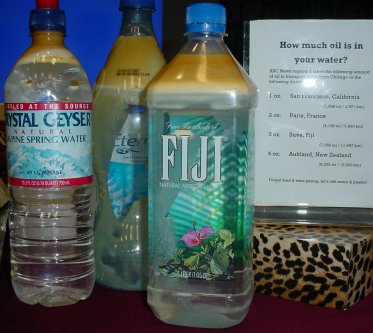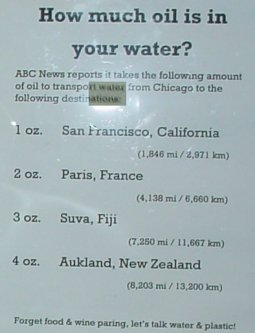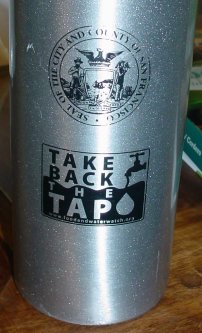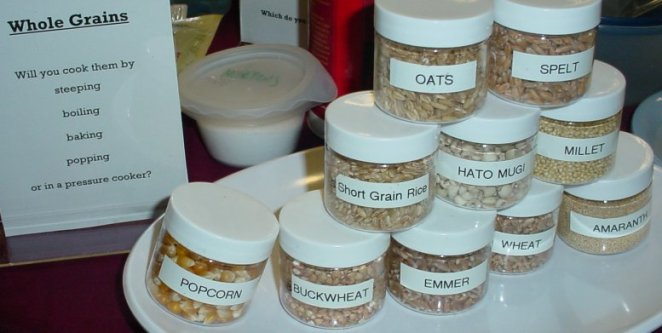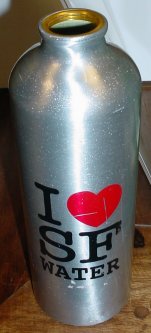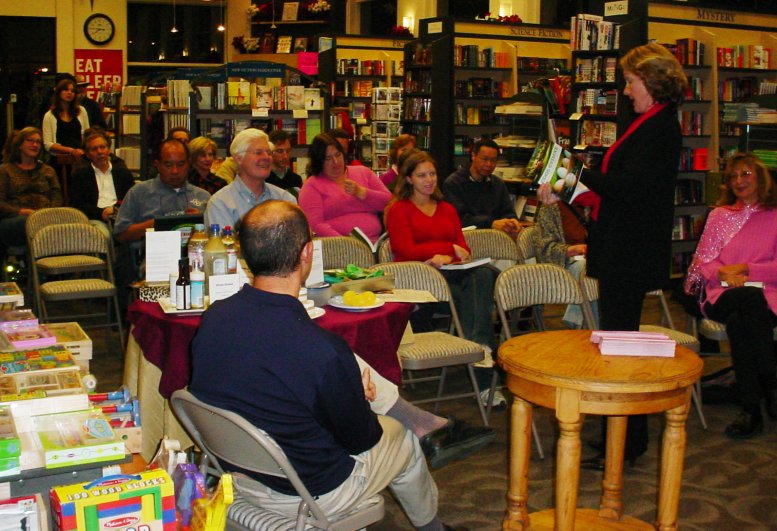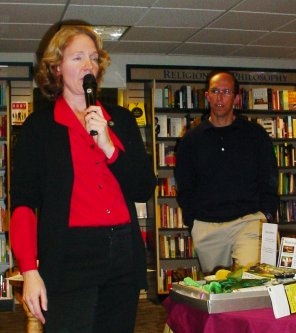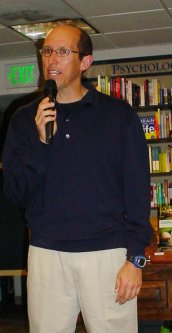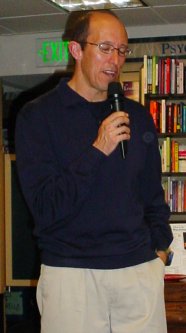When I got there they were setting up
these displays to give the presentation a more three dimensional
quality. The message of the above one was that tap water uses much less
energy to distribute than bottled water, which uses at least an ounce
per bottle to send it 2000 miles.
Looking at these grains, I was made
aware that I have no idea what "emmer" and "hato mugi" taste like,
never mind how to cook them.
The bookstore employee began the talk
by thanking us for coming, mentioning where the rest rooms were, and
introducing tonights first guest, the long time Palo Alto Acterra
organizer and
famous activist chef Laura Stec.
Laura started by asking us how many of
us were vegetarians. Some hands went up. She explained that a
vegetarian diet is one of the things that can make a difference in
one's carbon footprint, but only if it is done right. She and Eugene
had decided to do a book together a year and a half ago, partly because
they wanted to provide contexts for some ideas and fit them into a
useful framework. Because of that about half of the book is very
readable expositional material that the deep greens among us are
already aware of. The book also contains 50 recipes that she has
personally tested and many good cooking tips.
Then she said that 30% of the energy
Americans use goes into our food system. She listed the six largest
ways energy goes into our food. Livestock, the biggest among them,
didn't have to be on the list at all. The problem is the way we raise
it. Farmers like Joel Salatin use methods that are good for the soil,
good
for the environment, and produce very tasty food for very little
energy. The way industrial
agriculture does it requires additional fertilizers, additional
transportation, additional antibiotics, and is very resource intensive.
Learning how to shop for foods with lower carbon footprints is part of
what the book hopes to show readers.
Then Laura passed around a chart from the
book that showed the different carbon footprints of a stir fry, just
based on what ingredients are put into it.
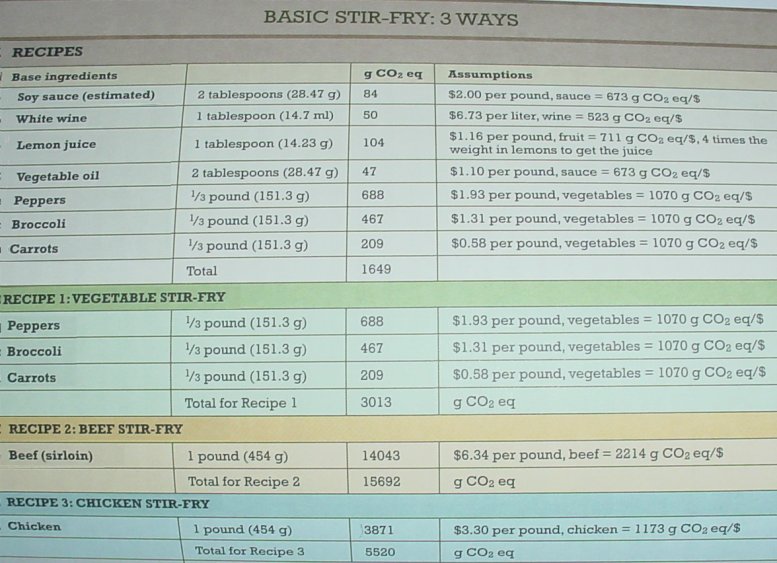
Then she explained the four "food
groups" a plant needs to grow are sunlight, water, nutrients (such as
nitrogen, and phosphorous), and carbon dioxide. What human induced
climate change means is that the carbon dioxide available from the
atmosphere has gone up 20% since the 1960s. She asked how we would
respond to 20% more anything in our diets in a rhetorical manner. This
change has even moved the range of some crops.
As the increased CO2 levels
in the atmosphere cause the dissolved CO2 in water to increase it makes
the ocean more acidic. This will result in calcium carbonate dissolving
out of coral reefs in much the way the shell of the egg she held up had
been dissolved by vinegar. Laura squeezed the egg, and it acted more
like a rubber ball than an egg. What would a coral reef be like without
its bones?
Laura said a few words about how much
spices can improve food. Then she introduced her coauthor,
Eugene Cordero, Ph.D.
Eugene explained that he works with the
intergovernmental panel on climate change, and is a meteorology
professor at San Jose State University. He had written the background
essays on Climate Change that are a big part of the book. He works with
his students to identify ways to improve methods of public education
that engage and stimulate social change. The book is his most ambitious
project in that vein to date. He is proud that it is easy to read, easy
to browse, and has many fun suggestions on how to do something tangible
in your own life with the
information provided.
The prepared talk ended with Laura
introducing two people in the audience that people could talk to if
they wanted to investigate further. The first was Gerald Lum from The
Peninsula Macrobiotic Community. They have been gathering at 6:30 PM on
Monday evenings at the church on the corner of California & Bryant
in Palo Alto to explore local organic vegetarian food for many years
now.
Click here to
find out more about that. The other was Deborah Olson, a fourth
generation farmer in Sunnyvale, one of the few remaining from that
tradition around here.
Click here to learn more about
her fruit stand on El Camino near Matilda.
The dried fruit plate Deborah Olson
brought was very popular. I tried all of the dried fruits, and they
were all great. It was piled high at the begining of the event, but I
hadn't a good opportunity to take a picture of it then.
The event ended with a book signing and
schmooze session. I got both authors to sign my copy.
Browsing the book while preparing this page, I've found many things
that were in the author talks, including most of the charts they passed
around. The charts above are from my copy of the book, because the
plastic coating on the pages passed around made them impossible to
photograph while listening.
